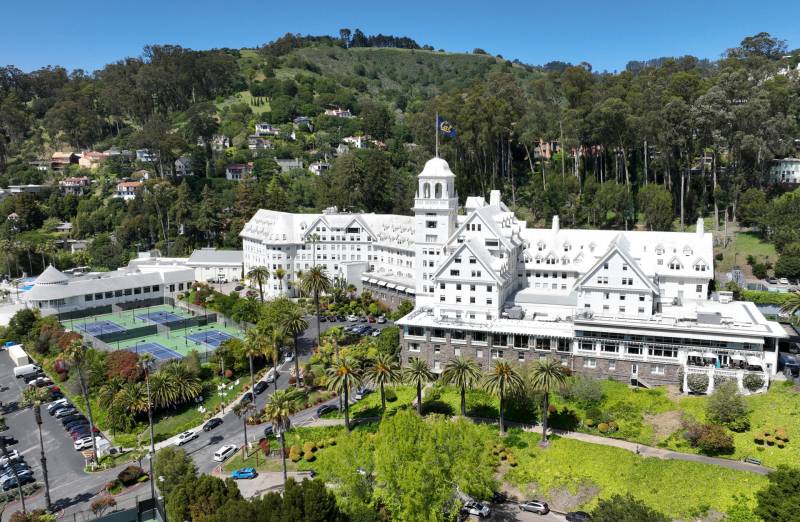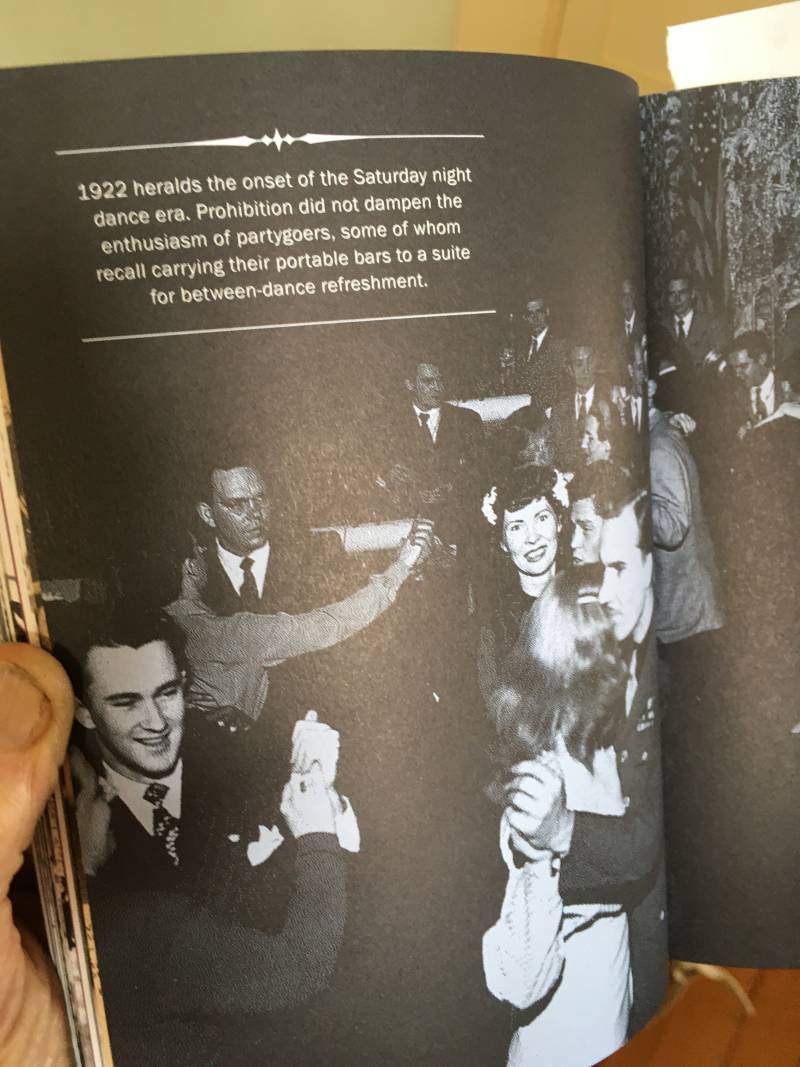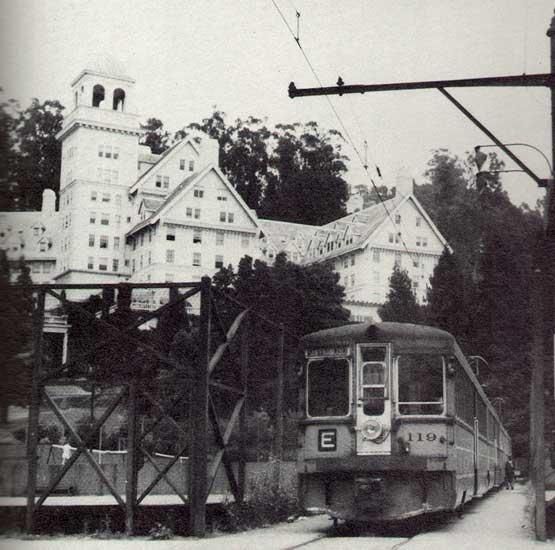Episode Transcript
This is a computer-generated transcript. While our team has reviewed it, there may be errors.
Olivia Allen Price: The historic Claremont Hotel in Oakland is nothing short of an absolute stunner, OK. It’s got a castle-like architecture that looks like nothing else in the Bay Area.
The whole façade is brilliantly white … like even the windows and roof tiles are white! So it really pops against the Eucalyptus grove behind it. And it’s bursting with amenities — a pool, tennis courts, a spa … the works.
But the one amenity it didn’t have for a very long time? A bar.
Sam Hopkins: It’s always interesting to me that you’d have this really grand hotel and it’s beautiful in every way but it operated for a long time without a bar.
Olivia Allen Price: This is Sam Hopkins of Oakland. He lives near the Claremont Hotel and over the years has heard a lot of speculation about why the hotel didn’t serve alcohol long before Prohibition took hold. Were the owners a part of the temperance movement, promoting abstinence from alcohol? Was there actually a speakeasy there?
Sam Hopkins: I’d heard there’s a legend or a myth about a Berkeley co-ed who was part of helping them get their liquor license. So that’s an interesting story too, though I don’t know if it’s true or not.
Olivia Allen Price: What took so long for the place to finally get a bar?
Sam Hopkins: Which just seems so crazy to think of a hotel without a bar, especially one of that stature.
Olivia Allen Price: Today on Bay Curious we’re answering Sam’s question, which was the winner of our July voting round on BayCurious.org. Today’s the last day to vote in August’s round, by the way, so be sure to check those questions out…
I’m Olivia Allen-Price. We’ll get to it after this quick break…
Olivia Allen Price: We’re answering Sam’s question about why the Claremont Hotel didn’t have a bar in its early years. Well, spoiler alert, they eventually did get a bar, and we sent reporter Katherine Monahan to check it out, try a drink and get the backstory…
[Sound of bartender shaking a cocktail in a crowded bar]
Katherine Monahan: The light is soaking in from the bay … reflecting off the textured metal ceiling. The floor is these … tiny black and white tiles radiating into hexagons. And…
[Sound of a drink being poured]
Katherine Monahan: …my drink is ready.
Katherine Monahan (on scene): What was the name of this again?
Bartender: Rosa Mexicano.
Katherine Monahan (on scene): It’s beautiful.
Katherine Monahan: It looks like a unicorn’s crystal jacuzzi. It’s all pink and frothy. It goes perfectly with the fairy tale castle look of this hotel. And the terrace, where I’m about to carry my drink?
Katherine Monahan (on scene): I can see the Bay Bridge. I can see the Golden Gate. I can see Mount Tam, Alcatraz, Treasure Island. That’s Angel Island. I mean this is spectacular.
Katherine Monahan: But the terrace bar hasn’t always been here. For decades, the Claremont Hotel didn’t have a bar at all. And to understand why, we’ll need to step all the way back to the late 1800s.
[Old-timey music]
Jef Findley: The theory was, alcohol was the root of all evil. So get rid of alcohol, and you’ll get rid of a lot of the evils.
Katherine Monahan: Jef Findley is the librarian at the Berkeley Public Library’s History Room.
Jef Findley: The temperance movement was really taking on.
Katherine Monahan: Prohibition was still 50 years in the future, and there was plenty of drinking going on. Northern California was considered especially depraved, full of gold-miners and ruffians.
[Saloon sound effects, someone get punched]
But that was where the first University of California was built – in downtown Oakland!
Jef Findley: The professors and the like found that it was in an unsavory part of Oakland because of bordellos and saloons.
Katherine Monahan: So in 1873, they moved it — to its present campus in Berkeley. Back then Berkeley was much more rural.
Jef Findley: It was populated probably by more cows than people at the time, it was considered as an okay place to send a bunch of 20-year-old men without having the evil influences of alcohol.
Katherine Monahan: To further protect the students, a state law was added: California penal code section 172, banning the sale of alcohol within two miles of UC Berkeley.
Jef Findley: But then, cooler heads prevailed in 1876. They reduced that to one mile.
Katherine Monahan: The Claremont Hotel would soon be built just under one mile away.
Now the UC trustees weren’t the only ones eyeing the East Bay hills. A pair of investors calling themselves the Realty Syndicate was buying up tens of thousands of acres. Which they would soon develop into some of the fanciest neighborhoods in the Bay Area.
Jef Findley: By about 1900, Francis “Borax” Smith acquired the property that the Claremont is on.
Katherine Monahan: Smith had earned his fortune — and his nickname — from borax, a mineral with household and industrial uses. He mined it in Death Valley and hauled it with a 20-mule team.
Jef Findley: Shortly after he acquired the property, however, in a game of checkers, he lost it.
Katherine Monahan (on scene): Checkers?
Jef Findley: Checkers. But he lost it to Frank Havens, a business partner of his.
Katherine Monahan: Since the property was within one mile of UC Berkeley — within the legal dry zone — Smith and Havens wouldn’t be able to sell alcohol on it. But they had a much larger scheme in mind.
Jef Findley: The people that were doing all this were all about making money.
Katherine Monahan: Smith had used his borax fortune to buy up all the streetcar lines in the Bay Area, and some ferries, and unify all of it into a single network called the Key System. So he and Havens were selling, not just sunny properties with beautiful views, but also a way to commute to work.
Go ahead and guess how long it took to get from Berkeley to the city in 1906 via electric train and ferry? 35 minutes!
Jef Findley: They really appealed to the people who had a lot of money that lived in San Francisco when it was destroyed by the earthquake. It’s like this is a great place to relocate.
Katherine Monahan: To entice potential homebuyers over from the city, Smith and Havens built a tourist attraction at the end of their new streetcar line: the biggest hotel on the west coast, shaped like a castle. The Claremont Hotel.
The opening was timed to go with the World’s Fair in San Francisco, the one that the Palace of Fine Arts was built for. It was 1915.
Katherine Monahan (on scene): So the train would have dropped us off right here.
Michelle Heston: Yeah, the train would have dropped off guests. And then you could walk up kind of this grand promenade under the stone masonry arch
Katherine Monahan (on scene): With all these same kind of flowers on the side?
Michelle Heston: Exactly.
Katherine Monahan: Michelle Heston is director of public relations for the Claremont Hotel. She says the original plan was for the trains to pull up right up into the lobby. But the station ended up outside, in front of the carriage entrance.
Michelle Heston: Imagine arriving right in your corset and your umbrella and your big steamer case
Katherine Monahan (on scene): I was wearing a corset? Did I have a horse?
Michelle Heston: (laughing) You were probably from a wealthy family. So you probably arrived in a carriage.
Katherine Monahan (on scene): Oh. of course.
Katherine Monahan: Heston shows me in through the stone archway, through the lobby, with its marble floors and velvet couches.
Katherine Monahan (on scene): Gosh it’s pretty
Michelle Heston: Isn’t it pretty?
Katherine Monahan: And into the hotel’s ballroom.
Katherine Monahan (on scene): It smells old – not in a bad way.
Michelle Heston: (giggles) No, it does.
Katherine Monahan: It’s a long, wide room, with thick columns, and a carpet, and a big built-in stage with a shiny curtain.
Michelle Heston: So this is where the band would have performed.
Katherine Monahan (on scene): And the dancers back here?
Michelle Heston: Exactly. And you’d have cocktail tables around the perimeter,
Katherine Monahan (on scene): But no cocktails!
Michelle Heston: (laughing) Yes, exactly.
Katherine Monahan (on scene): So it was not permitted for alcohol to be sold near the university. But prior to and after Prohibition, there was nothing against actually having alcohol or drinking it so far as I understand, right?
Michelle Heston: That’s what I understand as well. So what would you do? (laughing)
Katherine Monahan (on scene): I mean, come on. (both laughing)
Michelle Heston: I know what I’d do.
Katherine Monahan: So, just because the hotel couldn’t sell alcohol, doesn’t mean people didn’t bring it in. Then came Prohibition in 1920. Alcohol became completely illegal nationwide. But dancing was still okay.
[A Charleston tune plays]
Big bands performed at the Claremont all through the ’20s and ’30s.
[Ambience of people in a large ballroom, accompanied by music]
And the UC Berkeley students, those vulnerable, innocent students, came to dance! The Claremont ran advertisements in the Daily Cal, the student paper, for the college special: dancing, punch, and assorted sandwiches, for a dollar! The Daily Cal also had a column called Who’s Whooie, about what the cool kids were doing, and it was always talking about how so-and-so went out to the Claremont.
Heston says there are no records of a speakeasy in the hotel, but…
Michelle Heston: There were always private rooms in hotels, that locked from the inside, that guests could rent for the evenings, that were meant for events. So…
Katherine Monahan: We check out a 1922 photograph in a booklet of Claremont Hotel history. It shows jolly young men and women in suits and dresses, dancing in the ballroom.
Katherine Monahan (on scene): It says, “Prohibition did not dampen the enthusiasm of party goers, some of whom recall carrying their portable bars to a suite for between-dance refreshment.”
Michelle Heston: There you go, see?
Katherine Monahan (on scene): That’s what you’re talking about?
Michelle Heston: That’s what I’m talking about. Yeah.
Katherine Monahan (on scene): So it wasn’t even like they were sleeping in the suite necessarily.
Michelle Heston: Probably not.
Katherine Monahan: So on the surface, Berkeley kept it pretty lawful and wholesome. Unlike San Francisco and Oakland, which had obvious, active speakeasies and a reputation for not caring at all. But when Prohibition ended in 1933, that one-mile dry zone around the university finally started to hydrate. First, beer was permitted.
Then in 1937 the law changed again, to say that the one mile distance could be measured by road, rather than as the crow flies. According to legend…
Michelle Heston: It was a group of students that actually went and measured it out from the closest Cal campus building.
Katherine Monahan: And the hotel gave free drinks for life to the girl who showed that it was over a mile. At least, that’s how the story goes.
And so finally, after more than two decades of serving punch and tea and the like, the Claremont Hotel got to open a bar.
Lesley Emmington grew up right near the hotel.
Lesley Emmington: I heard it always referred to, and my cousin Lorraine going, “Oh, it was so much fun.”
Katherine Monahan: Emmington is just 80 years old — so she was too young to go to the bar when it first opened, shortly before WWII broke out. But her cousin Lorraine was a student at Cal at the time, and she used to love going there.
[1940s swinging jazz music]
Lesley Emmington: During the war, you see the guys would come. They’d come from Treasure Island. And you could come on the train. That would be a stop coming across the bridge. Sometimes the train would suddenly just be jammed with military guys. And then they could come to the Claremont, too, see? Because it was right on the train. It was built to be end of the line. So you could either go to the city, or you could come over to the Claremont.
Katherine Monahan (on scene): Wow. So, people coming to the Claremont just partying coming from the military.
Lesley Emmington: Yeah, I mean, the whole Bay Area was just jammed with American young men who’d never been west, of course. And they were here and they were on limited time. It was crawling with the men.
Katherine Monahan (on scene): And what did cousin Lorraine say about all that?
Lesley Emmington: Well, she loved it. (laughs)
Katherine Monahan: So, a good time was had by all, both with and without alcohol. And Berkeley eventually became the wild swinging Berkeley of the hippy era, but it took its time. It didn’t even allow people to dance and drink in the same room until the 1960s!
Here’s the part that’s the funniest to me: that one mile law, which dates all the way back to 1855 … is still on the books! It’s just been amended to bits, and obviously there are bars next to campus now. But the law is still there!
[Ambience of a college bar, patrons can be heard and a reggae tune]
So in honor of the old temperance movement and California penal code section 172, I am having one more drink, this time right across the street from UC Berkeley.
Katherine Monahan (on scene): Cheers!
Olivia Allen Price: That was KQED’s Katherine Monahan.
Before you go, I have a favor to ask. Could you open your podcast player and make sure you’re “Subscribed” to the Bay Curious podcast? Only a small percentage of listeners to this show are actually subscribed, and those subscription numbers really help us out. They also help you to make sure not to miss a future episode. Win-win, right? Thanks for subscribing!
Bay Curious is made by Amanda Font, Christopher Bveale and Olivia Allen-Price. Additional support from Jen Chien, Katie Sprenger, Cesar Saldana and Holly Kernan.
We will be dark next week so our team can rest up over Labor Day. We’ll be back on September 14th with a fresh episode.
I’m Olivia Allen-Price. Have a fantastic week!



